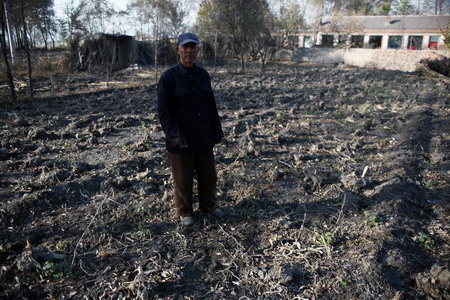Focus
Rare earth's surging price
By Gao Changxin (China Daily)
Updated: 2010-11-17 07:59
 |
Large Medium Small |
|
|
Wasting away
Baotou, which has a population of 2 million, is at the very heart of rare earth production and boasts the world's largest rare earth mine in Bayan Obo, which accounts for about 70 percent of China's total supply.
After city officials decided to base its economic development on rare earth in the 1980s, numerous refining and mining plants, both legal and illegal, emerged. While exporting the metals has helped in terms of fiscal growth, the highly polluting mining and refinery process has taken a heavy toll.
Twenty years ago, Xinguang village was a major vegetable production base, but today almost all 7,000 mu (467 hectares) of farmland is barren, a victim of pollution triggered by a string of refining plants about 2 kilometers away.
"The village has changed into a ghost town," said Hao Aiping, a gaunt-looking resident who gave his age as 38. "Most people here have gone into town, leaving only the old and sick."
His neighbor Hao Zengshan used to earn 30,000 yuan a year producing taro and cabbages on his 0.4 hectare of land; now all he can grow is the corn stacked under his windowsill.
Both villagers complained that every spring a wind blows an odorous mist from the refining plants into the village, stinging the eyes and skin. When the mist finally disappears, everything is covered with a film of brown dust and smells of coke.
Not far away from Xinguang is a reservoir called Weikuangba, which was built to contain the residue left by the city's rare earth refineries. Over the years, pollutants in the lake, which can hold 230 million cubic meters, have contaminated the underground water that feeds nearby wells used by villagers to water their crops and livestock.
Zhang Guang, 28, who works at one of the plants, said when the rainy reason arrives in July and August, the reservoir will flow to the Yellow River 10 km away. The river, the second longest in China, is a vital water source for northern regions.
Yet, for all the grave pollution, Baotou's residents have failed to see a decent return on its rare earth due to the cut-throat price wars and smuggling that are rampant in this fragmented and under-regulated industry.
Before the sudden hikes this year, the price of rare earth in China had risen by only about 20 percent between 1979 and 2008, excluding inflation.
In fact, because of the presence of small workshops like Weiming, the rare earth business in Baotou is actually running at a loss, according to An Sihu, assistant director of the Baotou Rare Earth High-Tech Zone and a former official with the city's development and reform commission.
"The money Baotou has earned by selling rare earth over the years is barely enough to cover its environmental protection bill," he said, explaining that the city has accumulatively spent more than 15 billion yuan in the last two decades on treating pollution caused by an industry with a turnover of just 2 billion yuan.
An blamed the low prices on smuggling by illegal miners and smelters. He estimated that more than 40,000 tons of rare earth was illegal shipped out of Baotou in 2009 - roughly the same as the country's official exports.
"For years, China's rare earth was sold cheaper than pork," said Ma Pengqi, managing director of the Chinese Society of Rare Earth and former member of State Council's rare earth leading group.
